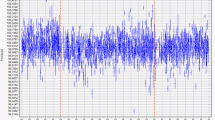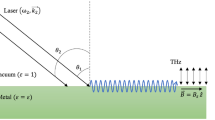Abstract
The surface current method and the pseudophoton method are widely used in the study of the interaction between relativistic electrons and matter. A simple analysis reveals the contradictions between these methods as to the excitation of the currents on the surface of the conducting target. To solve this contradiction, the surface currents on the downstream and upstream surfaces of the conducting target were measured in the geometry of the diffraction radiation. The surface currents were experimentally recorded on the upstream target surface, from which the backward diffraction radiation is generated. At the same time, the surface currents are absent on the downstream target surface, which is conventionally considered as a source of diffraction radiation in the direction of the motion of electrons. Analogous results were obtained in the same geometry in a beam of real photons. On the whole, these results confirm the applicability of the pseudophoton method for the analysis of the effects of the interaction between the field of relativistic photons and the thick (thicker than the skin layer) conducting targets and inapplicability of the surface current method for the radiation in the direction of motion of electrons.
Similar content being viewed by others
References
J. H. Brownell and J. Walsh, Phys. Rev. E 57, 1075 (1998).
S. Reiche and J. B. Rosenzweig, in Transition Radiation for Uneven, Limited Surfaces, Proceedings of the 2001 Particle Accelerator Conference (Chicago, 2001).
B. M. Bolotovskii, Tr. Fiz. Inst. AN SSSR 140, 95 (1982).
E. Fermi, Fizika 29, 315 (1924).
E. Wiliams, K. Danske Vidensk. Selsk. 13, 4 (1935).
M. L. Ter-Mikaelian, High Energy Electromagnetic Processes in Condensed Media (Wiley-Interscience, New York, 1972).
J. D. Jackson, Classical Electrodynamics, 3rd ed. (Wiley, New York, 1998).
B. N. Kalinin, G. A. Naumenko, A. P. Potylitsyn, G. A. Saruev, L. G. Sukhikh, and V. A. Cha, JETP Lett. 84, 110 (2006).
V. Sargsyan, Comparison of Stripline and Cavity Beam Position Monitors, TESLA Report 2004-03.
A. P. Kazantsev and G. I. Surdutovich, Dokl. Akad. Nauk SSSR 147, 74 (1962).
E. L. Feinberg, Sov. Phys. Usp. 23, 629 (1980).
N. F. Shul’ga, S. V. Trofimenko, and V. V. Syshchenko, JETP Lett. 93, 1 (2011).
G. Naumenko, X. Artru, A. Potylitsyn, Yu. Popov, L. Sukhikh, and M. Shevelev, J. Phys.: Conf. Ser. 236, 012004 (2010).
H. D. Thomsen, J. Esberg, K. K. Andersen, M. D. Lund, H. Knudsen, U. I. Uggerhoj, P. Sona, A. Mangiarotti, T. J. Ketel, A. Dizdar, S. Ballestrero, and S. H. Connell, Phys. Rev. D 81, 052003 (2010).
G. A. Naumenko, Y. A. Popov, and M. V. Shevelev, J. Phys.: Conf. Ser. 357, 1 (2012).
G. A. Naumenko, L. G. Sukhikh, Yu. A. Popov, and M. V. Shevelev, Nuovo Cimento C 35, 285 (2011).
Author information
Authors and Affiliations
Corresponding author
Additional information
Original Russian Text © G.A. Naumenko, A.P. Potylitsyn, M.V. Shevelev, V.V. Soboleva, V.V. Bleko, 2013, published in Pis’ma v Zhurnal Eksperimental’noi i Teoreticheskoi Fiziki, 2013, Vol. 98, No. 10, pp. 665–669.
Rights and permissions
About this article
Cite this article
Naumenko, G.A., Potylitsyn, A.P., Shevelev, M.V. et al. On the role of the surface currents in conducting targets in the formation of the diffraction and transition radiation of relativistic electrons. Jetp Lett. 98, 593–597 (2014). https://doi.org/10.1134/S0021364013230094
Received:
Published:
Issue Date:
DOI: https://doi.org/10.1134/S0021364013230094




